Singapore Gastronomic Tourism of South Korean Tourists: A Study
VerifiedAdded on 2020/03/16
|23
|4805
|796
Report
AI Summary
This report investigates the gastronomic tourism of South Korean tourists in Singapore. It begins with an introduction to food tourism and food travelers, followed by a literature review that explores factors influencing gastronomic tourism, theoretical frameworks, and the evolution of the gastronomic tourism industry in Singapore. The research methodology section details the primary data collection through a survey of 48 South Korean tourists. The report then presents and analyzes the survey results, addressing research questions related to the purpose of visits, food quality perceptions, restaurant service satisfaction, and significant factors in choosing dishes and destinations for gastronomic tourism. Findings indicate a strong interest in Singapore's culinary offerings among South Korean tourists. The report concludes with recommendations for enhancing Singapore's appeal as a gastronomic destination and provides suggestions for future research in this area.
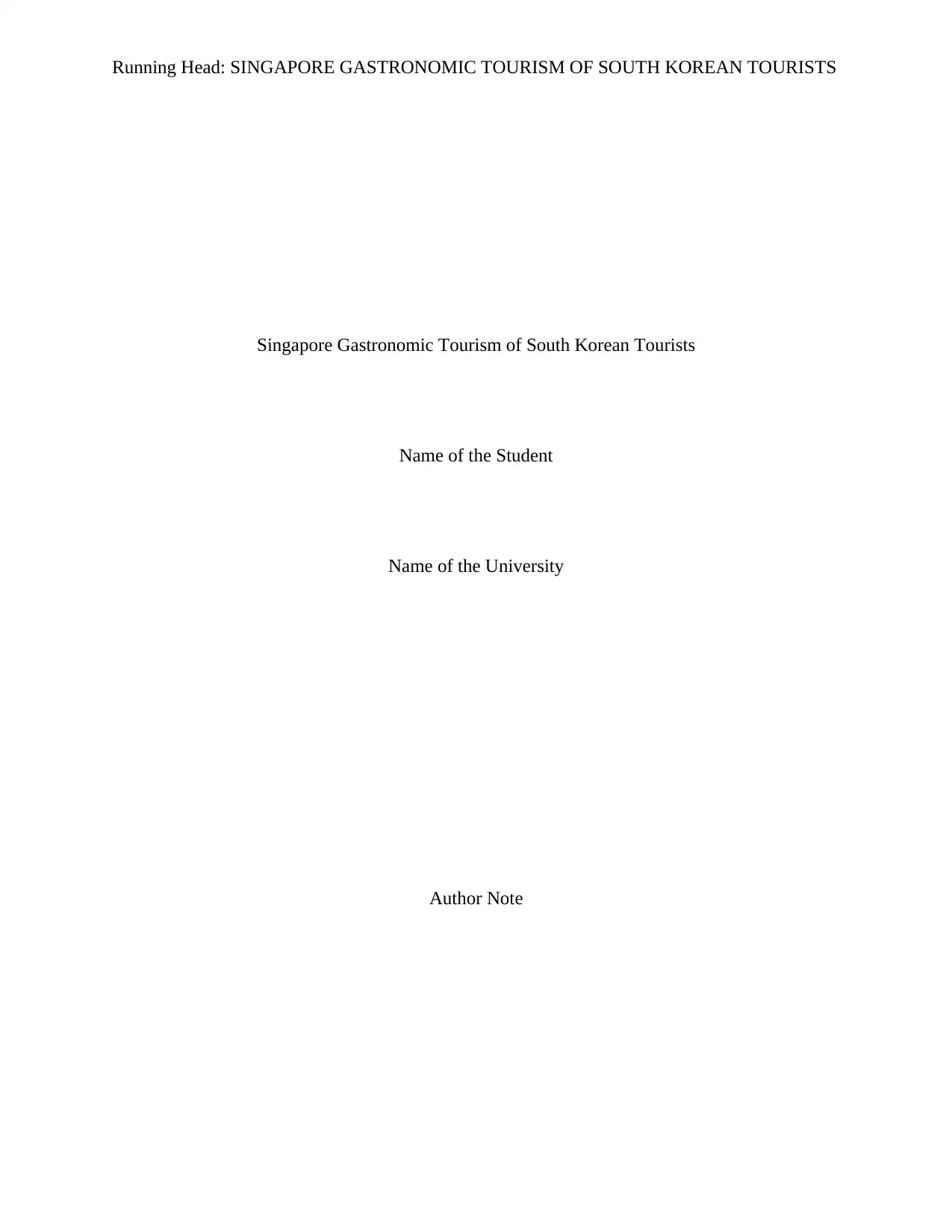
Running Head: SINGAPORE GASTRONOMIC TOURISM OF SOUTH KOREAN TOURISTS
Singapore Gastronomic Tourism of South Korean Tourists
Name of the Student
Name of the University
Author Note
Singapore Gastronomic Tourism of South Korean Tourists
Name of the Student
Name of the University
Author Note
Paraphrase This Document
Need a fresh take? Get an instant paraphrase of this document with our AI Paraphraser
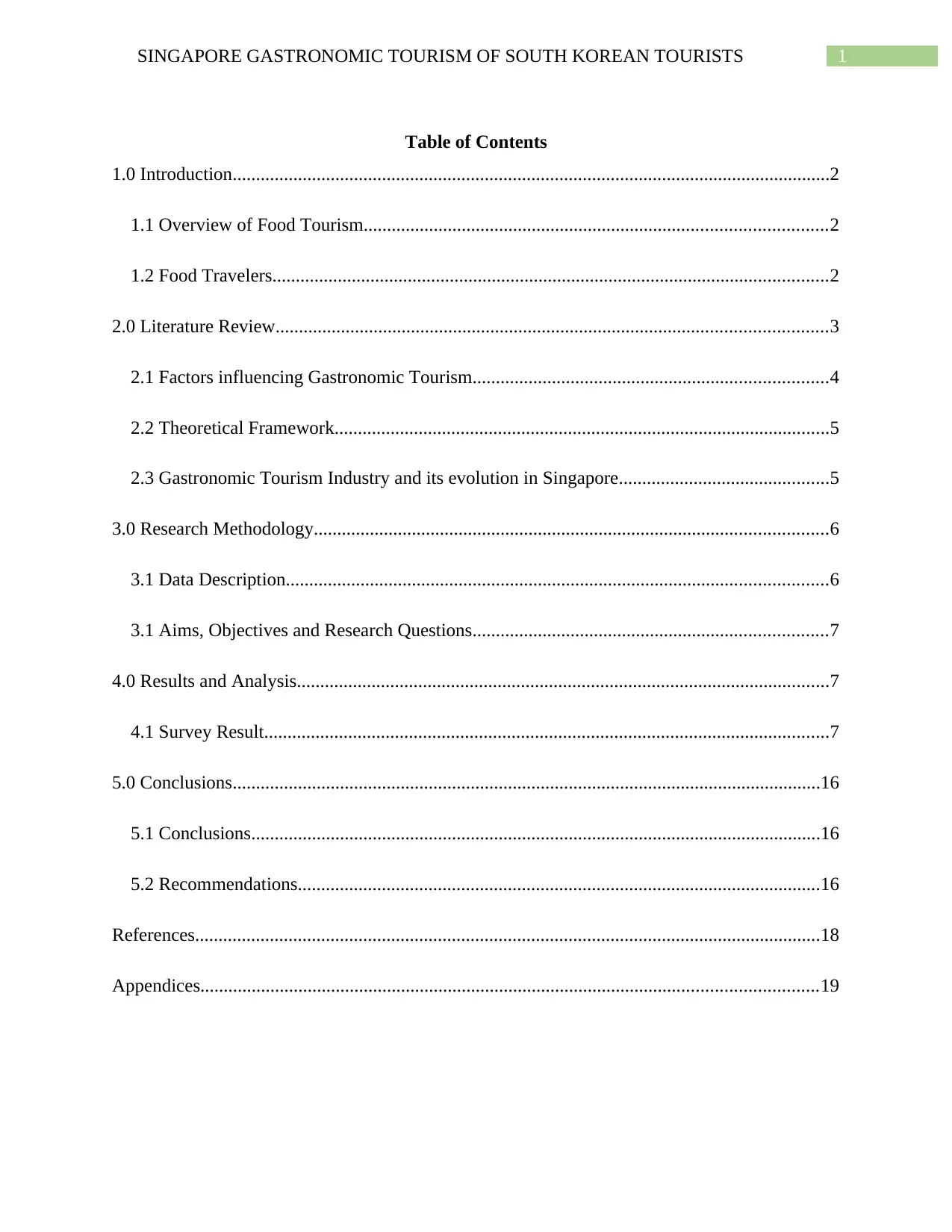
1SINGAPORE GASTRONOMIC TOURISM OF SOUTH KOREAN TOURISTS
Table of Contents
1.0 Introduction................................................................................................................................2
1.1 Overview of Food Tourism...................................................................................................2
1.2 Food Travelers.......................................................................................................................2
2.0 Literature Review......................................................................................................................3
2.1 Factors influencing Gastronomic Tourism............................................................................4
2.2 Theoretical Framework..........................................................................................................5
2.3 Gastronomic Tourism Industry and its evolution in Singapore.............................................5
3.0 Research Methodology..............................................................................................................6
3.1 Data Description....................................................................................................................6
3.1 Aims, Objectives and Research Questions............................................................................7
4.0 Results and Analysis..................................................................................................................7
4.1 Survey Result.........................................................................................................................7
5.0 Conclusions..............................................................................................................................16
5.1 Conclusions..........................................................................................................................16
5.2 Recommendations................................................................................................................16
References......................................................................................................................................18
Appendices....................................................................................................................................19
Table of Contents
1.0 Introduction................................................................................................................................2
1.1 Overview of Food Tourism...................................................................................................2
1.2 Food Travelers.......................................................................................................................2
2.0 Literature Review......................................................................................................................3
2.1 Factors influencing Gastronomic Tourism............................................................................4
2.2 Theoretical Framework..........................................................................................................5
2.3 Gastronomic Tourism Industry and its evolution in Singapore.............................................5
3.0 Research Methodology..............................................................................................................6
3.1 Data Description....................................................................................................................6
3.1 Aims, Objectives and Research Questions............................................................................7
4.0 Results and Analysis..................................................................................................................7
4.1 Survey Result.........................................................................................................................7
5.0 Conclusions..............................................................................................................................16
5.1 Conclusions..........................................................................................................................16
5.2 Recommendations................................................................................................................16
References......................................................................................................................................18
Appendices....................................................................................................................................19
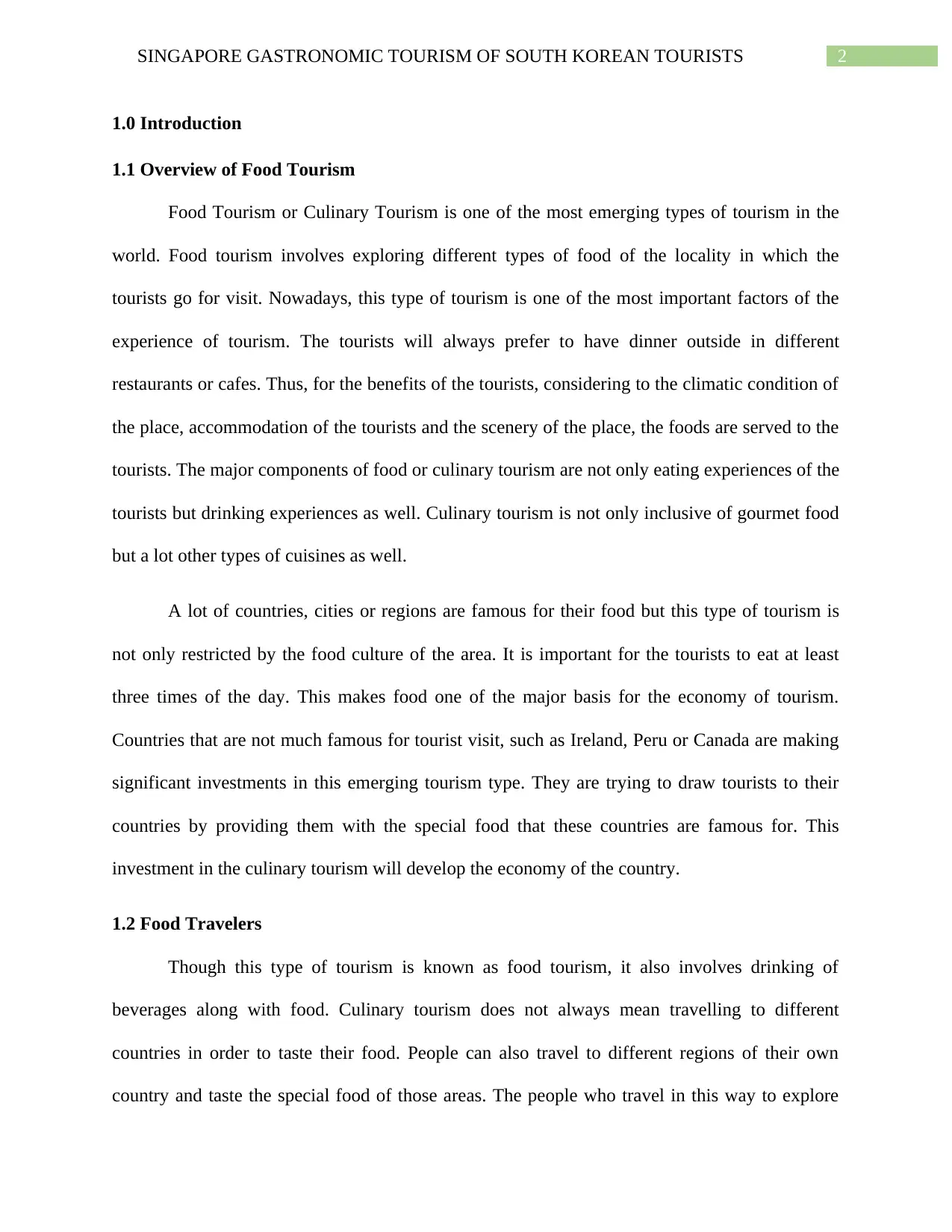
2SINGAPORE GASTRONOMIC TOURISM OF SOUTH KOREAN TOURISTS
1.0 Introduction
1.1 Overview of Food Tourism
Food Tourism or Culinary Tourism is one of the most emerging types of tourism in the
world. Food tourism involves exploring different types of food of the locality in which the
tourists go for visit. Nowadays, this type of tourism is one of the most important factors of the
experience of tourism. The tourists will always prefer to have dinner outside in different
restaurants or cafes. Thus, for the benefits of the tourists, considering to the climatic condition of
the place, accommodation of the tourists and the scenery of the place, the foods are served to the
tourists. The major components of food or culinary tourism are not only eating experiences of the
tourists but drinking experiences as well. Culinary tourism is not only inclusive of gourmet food
but a lot other types of cuisines as well.
A lot of countries, cities or regions are famous for their food but this type of tourism is
not only restricted by the food culture of the area. It is important for the tourists to eat at least
three times of the day. This makes food one of the major basis for the economy of tourism.
Countries that are not much famous for tourist visit, such as Ireland, Peru or Canada are making
significant investments in this emerging tourism type. They are trying to draw tourists to their
countries by providing them with the special food that these countries are famous for. This
investment in the culinary tourism will develop the economy of the country.
1.2 Food Travelers
Though this type of tourism is known as food tourism, it also involves drinking of
beverages along with food. Culinary tourism does not always mean travelling to different
countries in order to taste their food. People can also travel to different regions of their own
country and taste the special food of those areas. The people who travel in this way to explore
1.0 Introduction
1.1 Overview of Food Tourism
Food Tourism or Culinary Tourism is one of the most emerging types of tourism in the
world. Food tourism involves exploring different types of food of the locality in which the
tourists go for visit. Nowadays, this type of tourism is one of the most important factors of the
experience of tourism. The tourists will always prefer to have dinner outside in different
restaurants or cafes. Thus, for the benefits of the tourists, considering to the climatic condition of
the place, accommodation of the tourists and the scenery of the place, the foods are served to the
tourists. The major components of food or culinary tourism are not only eating experiences of the
tourists but drinking experiences as well. Culinary tourism is not only inclusive of gourmet food
but a lot other types of cuisines as well.
A lot of countries, cities or regions are famous for their food but this type of tourism is
not only restricted by the food culture of the area. It is important for the tourists to eat at least
three times of the day. This makes food one of the major basis for the economy of tourism.
Countries that are not much famous for tourist visit, such as Ireland, Peru or Canada are making
significant investments in this emerging tourism type. They are trying to draw tourists to their
countries by providing them with the special food that these countries are famous for. This
investment in the culinary tourism will develop the economy of the country.
1.2 Food Travelers
Though this type of tourism is known as food tourism, it also involves drinking of
beverages along with food. Culinary tourism does not always mean travelling to different
countries in order to taste their food. People can also travel to different regions of their own
country and taste the special food of those areas. The people who travel in this way to explore
⊘ This is a preview!⊘
Do you want full access?
Subscribe today to unlock all pages.

Trusted by 1+ million students worldwide
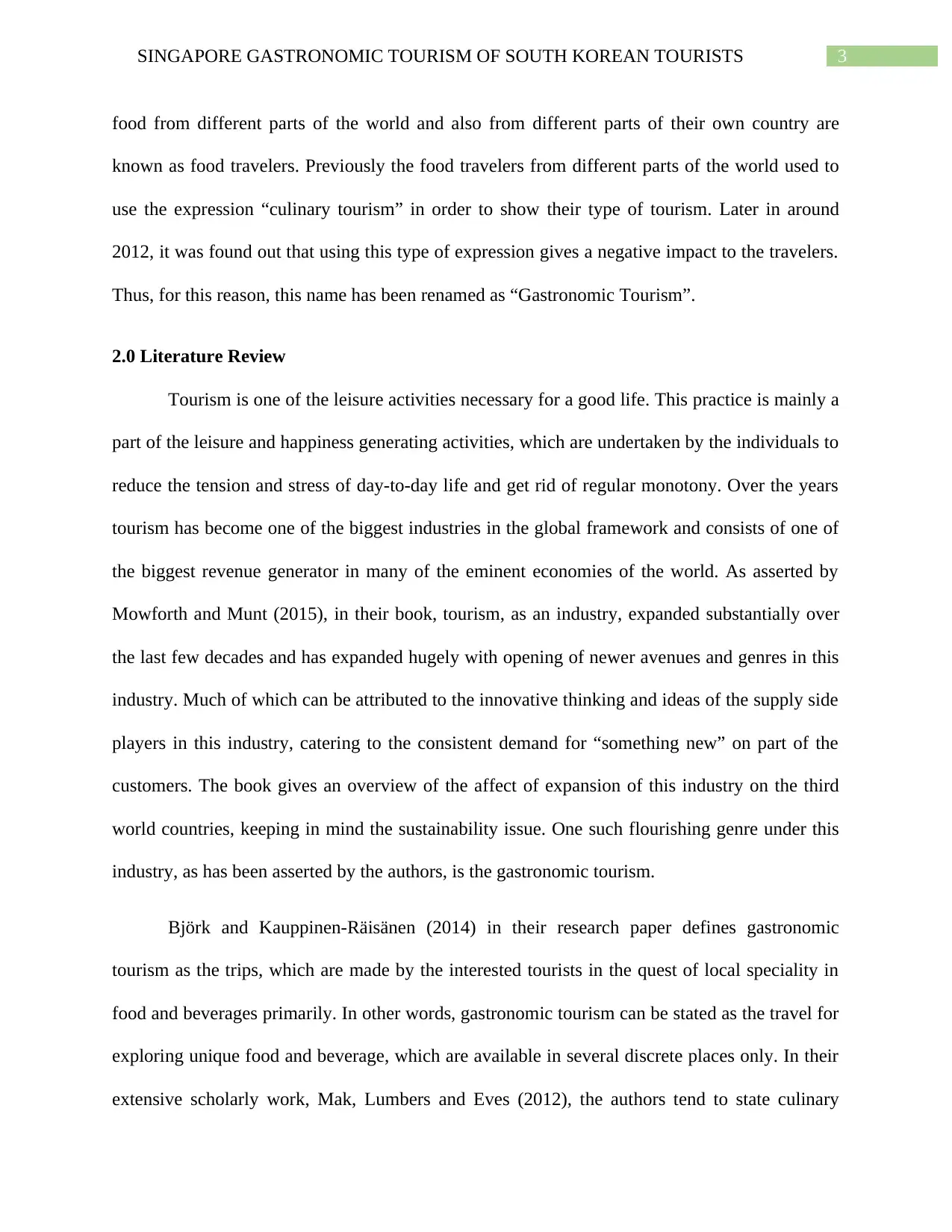
3SINGAPORE GASTRONOMIC TOURISM OF SOUTH KOREAN TOURISTS
food from different parts of the world and also from different parts of their own country are
known as food travelers. Previously the food travelers from different parts of the world used to
use the expression “culinary tourism” in order to show their type of tourism. Later in around
2012, it was found out that using this type of expression gives a negative impact to the travelers.
Thus, for this reason, this name has been renamed as “Gastronomic Tourism”.
2.0 Literature Review
Tourism is one of the leisure activities necessary for a good life. This practice is mainly a
part of the leisure and happiness generating activities, which are undertaken by the individuals to
reduce the tension and stress of day-to-day life and get rid of regular monotony. Over the years
tourism has become one of the biggest industries in the global framework and consists of one of
the biggest revenue generator in many of the eminent economies of the world. As asserted by
Mowforth and Munt (2015), in their book, tourism, as an industry, expanded substantially over
the last few decades and has expanded hugely with opening of newer avenues and genres in this
industry. Much of which can be attributed to the innovative thinking and ideas of the supply side
players in this industry, catering to the consistent demand for “something new” on part of the
customers. The book gives an overview of the affect of expansion of this industry on the third
world countries, keeping in mind the sustainability issue. One such flourishing genre under this
industry, as has been asserted by the authors, is the gastronomic tourism.
Björk and Kauppinen-Räisänen (2014) in their research paper defines gastronomic
tourism as the trips, which are made by the interested tourists in the quest of local speciality in
food and beverages primarily. In other words, gastronomic tourism can be stated as the travel for
exploring unique food and beverage, which are available in several discrete places only. In their
extensive scholarly work, Mak, Lumbers and Eves (2012), the authors tend to state culinary
food from different parts of the world and also from different parts of their own country are
known as food travelers. Previously the food travelers from different parts of the world used to
use the expression “culinary tourism” in order to show their type of tourism. Later in around
2012, it was found out that using this type of expression gives a negative impact to the travelers.
Thus, for this reason, this name has been renamed as “Gastronomic Tourism”.
2.0 Literature Review
Tourism is one of the leisure activities necessary for a good life. This practice is mainly a
part of the leisure and happiness generating activities, which are undertaken by the individuals to
reduce the tension and stress of day-to-day life and get rid of regular monotony. Over the years
tourism has become one of the biggest industries in the global framework and consists of one of
the biggest revenue generator in many of the eminent economies of the world. As asserted by
Mowforth and Munt (2015), in their book, tourism, as an industry, expanded substantially over
the last few decades and has expanded hugely with opening of newer avenues and genres in this
industry. Much of which can be attributed to the innovative thinking and ideas of the supply side
players in this industry, catering to the consistent demand for “something new” on part of the
customers. The book gives an overview of the affect of expansion of this industry on the third
world countries, keeping in mind the sustainability issue. One such flourishing genre under this
industry, as has been asserted by the authors, is the gastronomic tourism.
Björk and Kauppinen-Räisänen (2014) in their research paper defines gastronomic
tourism as the trips, which are made by the interested tourists in the quest of local speciality in
food and beverages primarily. In other words, gastronomic tourism can be stated as the travel for
exploring unique food and beverage, which are available in several discrete places only. In their
extensive scholarly work, Mak, Lumbers and Eves (2012), the authors tend to state culinary
Paraphrase This Document
Need a fresh take? Get an instant paraphrase of this document with our AI Paraphraser
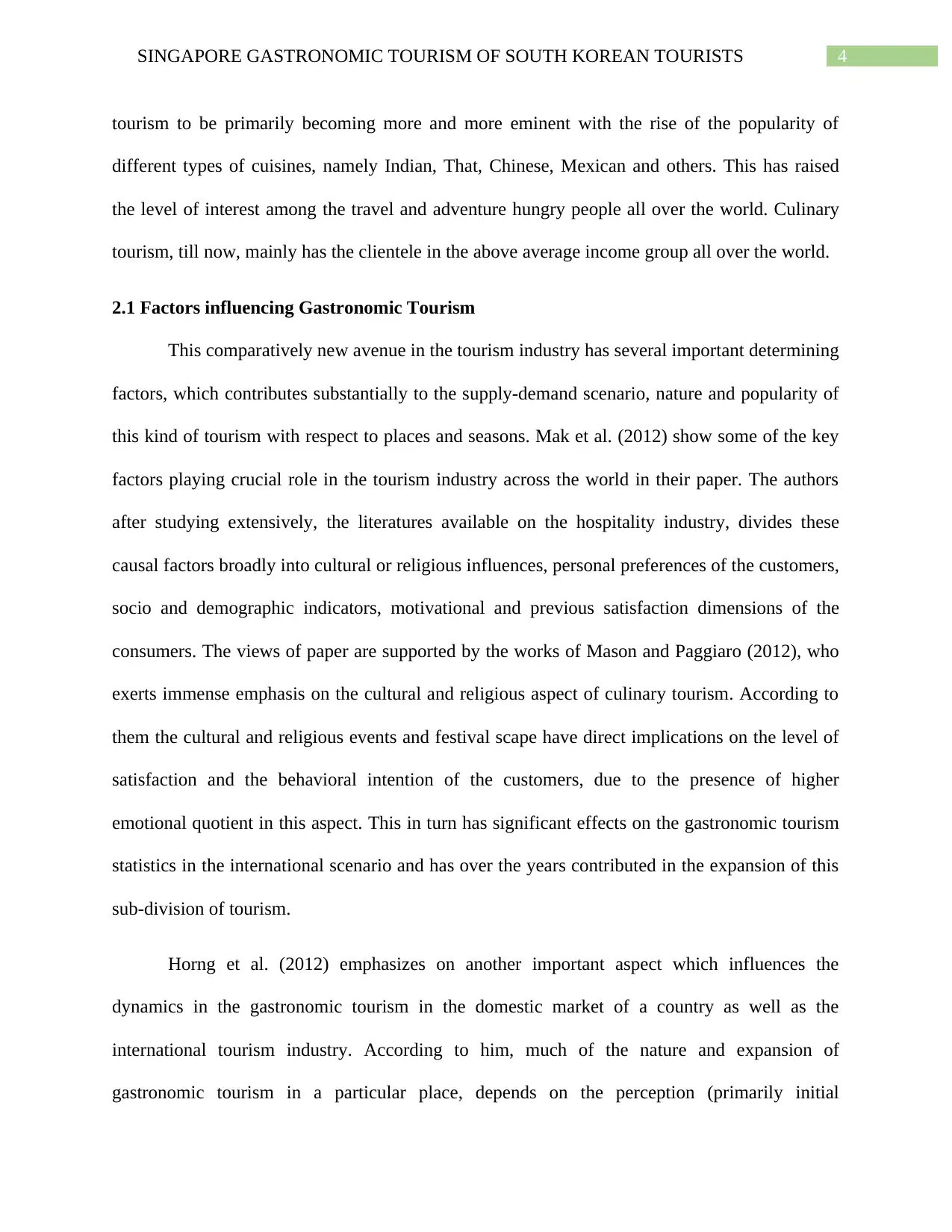
4SINGAPORE GASTRONOMIC TOURISM OF SOUTH KOREAN TOURISTS
tourism to be primarily becoming more and more eminent with the rise of the popularity of
different types of cuisines, namely Indian, That, Chinese, Mexican and others. This has raised
the level of interest among the travel and adventure hungry people all over the world. Culinary
tourism, till now, mainly has the clientele in the above average income group all over the world.
2.1 Factors influencing Gastronomic Tourism
This comparatively new avenue in the tourism industry has several important determining
factors, which contributes substantially to the supply-demand scenario, nature and popularity of
this kind of tourism with respect to places and seasons. Mak et al. (2012) show some of the key
factors playing crucial role in the tourism industry across the world in their paper. The authors
after studying extensively, the literatures available on the hospitality industry, divides these
causal factors broadly into cultural or religious influences, personal preferences of the customers,
socio and demographic indicators, motivational and previous satisfaction dimensions of the
consumers. The views of paper are supported by the works of Mason and Paggiaro (2012), who
exerts immense emphasis on the cultural and religious aspect of culinary tourism. According to
them the cultural and religious events and festival scape have direct implications on the level of
satisfaction and the behavioral intention of the customers, due to the presence of higher
emotional quotient in this aspect. This in turn has significant effects on the gastronomic tourism
statistics in the international scenario and has over the years contributed in the expansion of this
sub-division of tourism.
Horng et al. (2012) emphasizes on another important aspect which influences the
dynamics in the gastronomic tourism in the domestic market of a country as well as the
international tourism industry. According to him, much of the nature and expansion of
gastronomic tourism in a particular place, depends on the perception (primarily initial
tourism to be primarily becoming more and more eminent with the rise of the popularity of
different types of cuisines, namely Indian, That, Chinese, Mexican and others. This has raised
the level of interest among the travel and adventure hungry people all over the world. Culinary
tourism, till now, mainly has the clientele in the above average income group all over the world.
2.1 Factors influencing Gastronomic Tourism
This comparatively new avenue in the tourism industry has several important determining
factors, which contributes substantially to the supply-demand scenario, nature and popularity of
this kind of tourism with respect to places and seasons. Mak et al. (2012) show some of the key
factors playing crucial role in the tourism industry across the world in their paper. The authors
after studying extensively, the literatures available on the hospitality industry, divides these
causal factors broadly into cultural or religious influences, personal preferences of the customers,
socio and demographic indicators, motivational and previous satisfaction dimensions of the
consumers. The views of paper are supported by the works of Mason and Paggiaro (2012), who
exerts immense emphasis on the cultural and religious aspect of culinary tourism. According to
them the cultural and religious events and festival scape have direct implications on the level of
satisfaction and the behavioral intention of the customers, due to the presence of higher
emotional quotient in this aspect. This in turn has significant effects on the gastronomic tourism
statistics in the international scenario and has over the years contributed in the expansion of this
sub-division of tourism.
Horng et al. (2012) emphasizes on another important aspect which influences the
dynamics in the gastronomic tourism in the domestic market of a country as well as the
international tourism industry. According to him, much of the nature and expansion of
gastronomic tourism in a particular place, depends on the perception (primarily initial
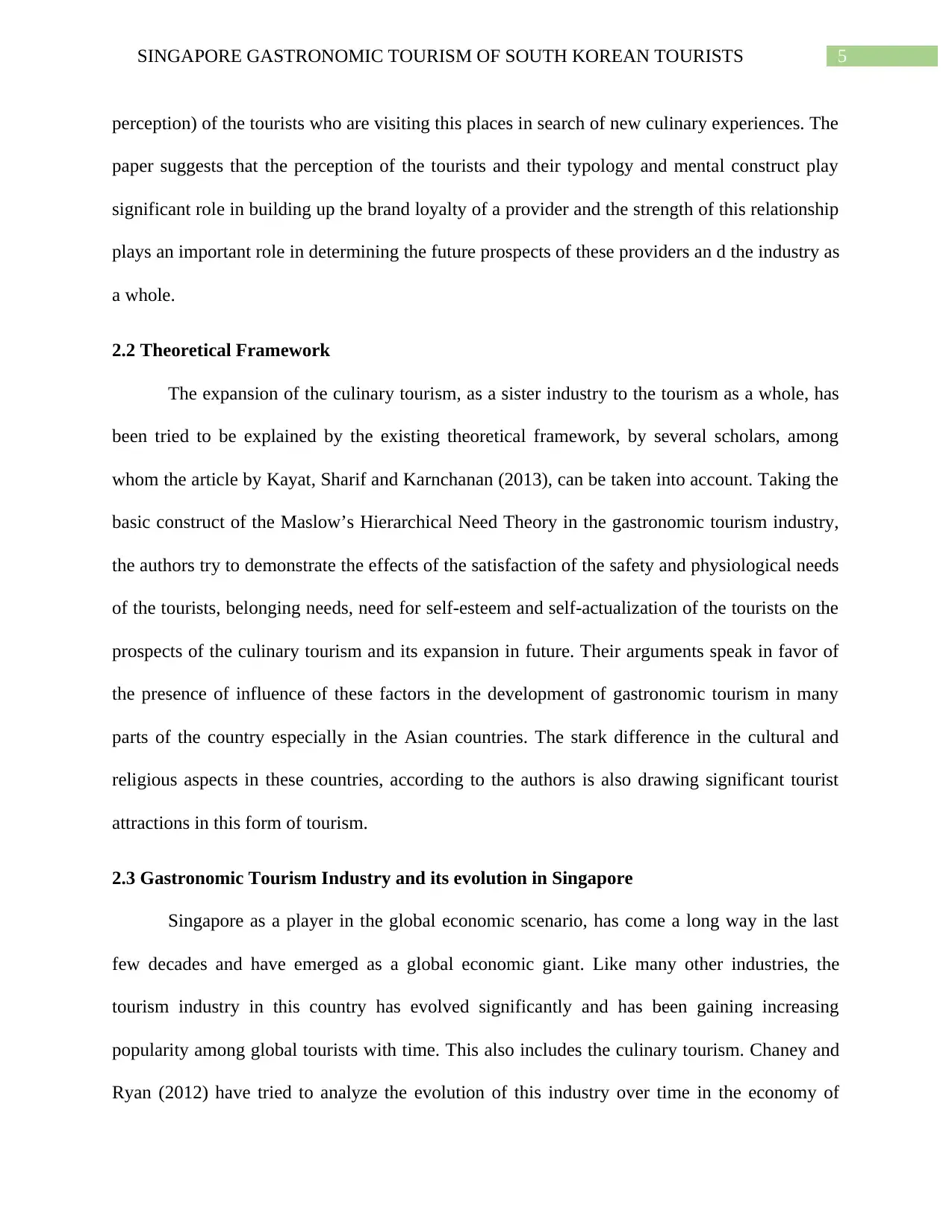
5SINGAPORE GASTRONOMIC TOURISM OF SOUTH KOREAN TOURISTS
perception) of the tourists who are visiting this places in search of new culinary experiences. The
paper suggests that the perception of the tourists and their typology and mental construct play
significant role in building up the brand loyalty of a provider and the strength of this relationship
plays an important role in determining the future prospects of these providers an d the industry as
a whole.
2.2 Theoretical Framework
The expansion of the culinary tourism, as a sister industry to the tourism as a whole, has
been tried to be explained by the existing theoretical framework, by several scholars, among
whom the article by Kayat, Sharif and Karnchanan (2013), can be taken into account. Taking the
basic construct of the Maslow’s Hierarchical Need Theory in the gastronomic tourism industry,
the authors try to demonstrate the effects of the satisfaction of the safety and physiological needs
of the tourists, belonging needs, need for self-esteem and self-actualization of the tourists on the
prospects of the culinary tourism and its expansion in future. Their arguments speak in favor of
the presence of influence of these factors in the development of gastronomic tourism in many
parts of the country especially in the Asian countries. The stark difference in the cultural and
religious aspects in these countries, according to the authors is also drawing significant tourist
attractions in this form of tourism.
2.3 Gastronomic Tourism Industry and its evolution in Singapore
Singapore as a player in the global economic scenario, has come a long way in the last
few decades and have emerged as a global economic giant. Like many other industries, the
tourism industry in this country has evolved significantly and has been gaining increasing
popularity among global tourists with time. This also includes the culinary tourism. Chaney and
Ryan (2012) have tried to analyze the evolution of this industry over time in the economy of
perception) of the tourists who are visiting this places in search of new culinary experiences. The
paper suggests that the perception of the tourists and their typology and mental construct play
significant role in building up the brand loyalty of a provider and the strength of this relationship
plays an important role in determining the future prospects of these providers an d the industry as
a whole.
2.2 Theoretical Framework
The expansion of the culinary tourism, as a sister industry to the tourism as a whole, has
been tried to be explained by the existing theoretical framework, by several scholars, among
whom the article by Kayat, Sharif and Karnchanan (2013), can be taken into account. Taking the
basic construct of the Maslow’s Hierarchical Need Theory in the gastronomic tourism industry,
the authors try to demonstrate the effects of the satisfaction of the safety and physiological needs
of the tourists, belonging needs, need for self-esteem and self-actualization of the tourists on the
prospects of the culinary tourism and its expansion in future. Their arguments speak in favor of
the presence of influence of these factors in the development of gastronomic tourism in many
parts of the country especially in the Asian countries. The stark difference in the cultural and
religious aspects in these countries, according to the authors is also drawing significant tourist
attractions in this form of tourism.
2.3 Gastronomic Tourism Industry and its evolution in Singapore
Singapore as a player in the global economic scenario, has come a long way in the last
few decades and have emerged as a global economic giant. Like many other industries, the
tourism industry in this country has evolved significantly and has been gaining increasing
popularity among global tourists with time. This also includes the culinary tourism. Chaney and
Ryan (2012) have tried to analyze the evolution of this industry over time in the economy of
⊘ This is a preview!⊘
Do you want full access?
Subscribe today to unlock all pages.

Trusted by 1+ million students worldwide
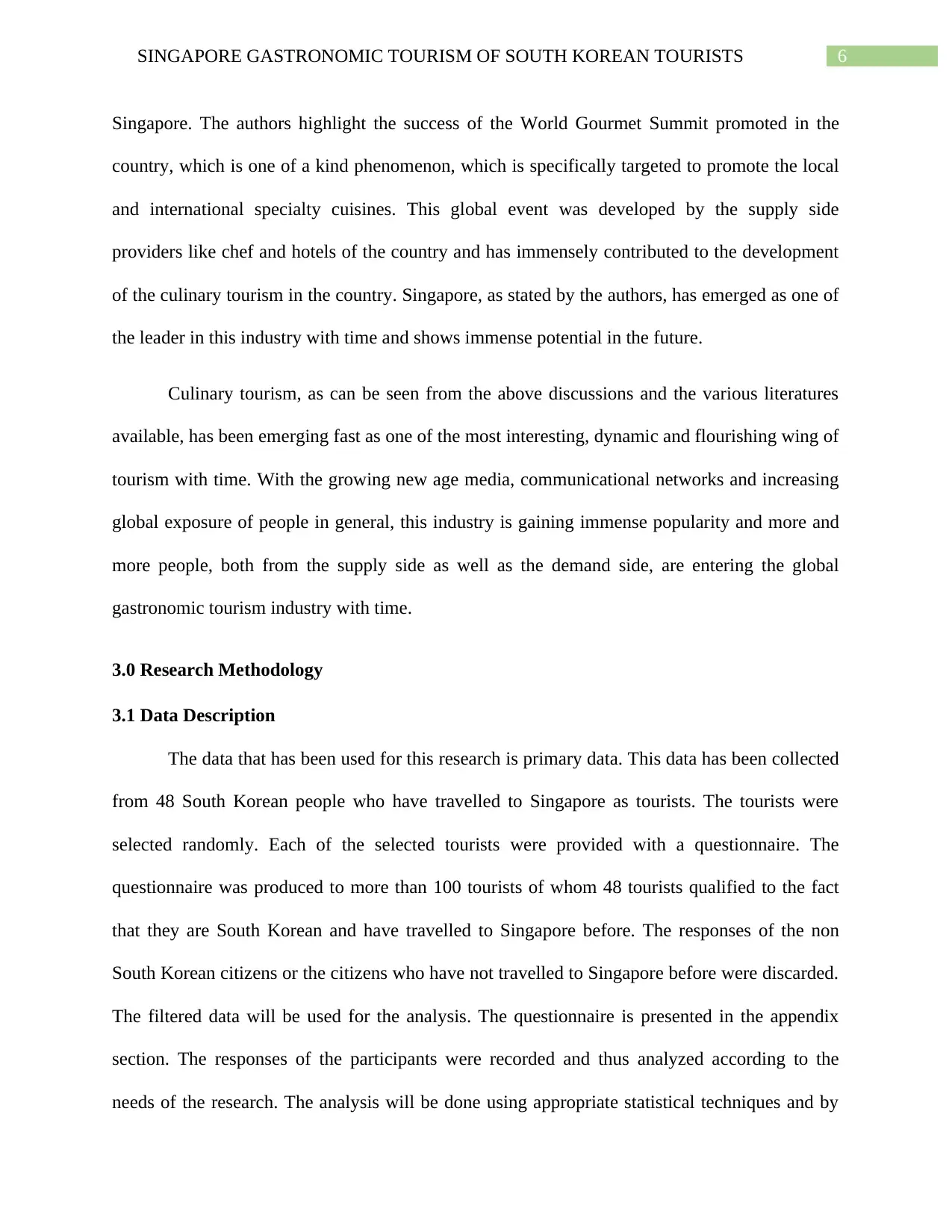
6SINGAPORE GASTRONOMIC TOURISM OF SOUTH KOREAN TOURISTS
Singapore. The authors highlight the success of the World Gourmet Summit promoted in the
country, which is one of a kind phenomenon, which is specifically targeted to promote the local
and international specialty cuisines. This global event was developed by the supply side
providers like chef and hotels of the country and has immensely contributed to the development
of the culinary tourism in the country. Singapore, as stated by the authors, has emerged as one of
the leader in this industry with time and shows immense potential in the future.
Culinary tourism, as can be seen from the above discussions and the various literatures
available, has been emerging fast as one of the most interesting, dynamic and flourishing wing of
tourism with time. With the growing new age media, communicational networks and increasing
global exposure of people in general, this industry is gaining immense popularity and more and
more people, both from the supply side as well as the demand side, are entering the global
gastronomic tourism industry with time.
3.0 Research Methodology
3.1 Data Description
The data that has been used for this research is primary data. This data has been collected
from 48 South Korean people who have travelled to Singapore as tourists. The tourists were
selected randomly. Each of the selected tourists were provided with a questionnaire. The
questionnaire was produced to more than 100 tourists of whom 48 tourists qualified to the fact
that they are South Korean and have travelled to Singapore before. The responses of the non
South Korean citizens or the citizens who have not travelled to Singapore before were discarded.
The filtered data will be used for the analysis. The questionnaire is presented in the appendix
section. The responses of the participants were recorded and thus analyzed according to the
needs of the research. The analysis will be done using appropriate statistical techniques and by
Singapore. The authors highlight the success of the World Gourmet Summit promoted in the
country, which is one of a kind phenomenon, which is specifically targeted to promote the local
and international specialty cuisines. This global event was developed by the supply side
providers like chef and hotels of the country and has immensely contributed to the development
of the culinary tourism in the country. Singapore, as stated by the authors, has emerged as one of
the leader in this industry with time and shows immense potential in the future.
Culinary tourism, as can be seen from the above discussions and the various literatures
available, has been emerging fast as one of the most interesting, dynamic and flourishing wing of
tourism with time. With the growing new age media, communicational networks and increasing
global exposure of people in general, this industry is gaining immense popularity and more and
more people, both from the supply side as well as the demand side, are entering the global
gastronomic tourism industry with time.
3.0 Research Methodology
3.1 Data Description
The data that has been used for this research is primary data. This data has been collected
from 48 South Korean people who have travelled to Singapore as tourists. The tourists were
selected randomly. Each of the selected tourists were provided with a questionnaire. The
questionnaire was produced to more than 100 tourists of whom 48 tourists qualified to the fact
that they are South Korean and have travelled to Singapore before. The responses of the non
South Korean citizens or the citizens who have not travelled to Singapore before were discarded.
The filtered data will be used for the analysis. The questionnaire is presented in the appendix
section. The responses of the participants were recorded and thus analyzed according to the
needs of the research. The analysis will be done using appropriate statistical techniques and by
Paraphrase This Document
Need a fresh take? Get an instant paraphrase of this document with our AI Paraphraser
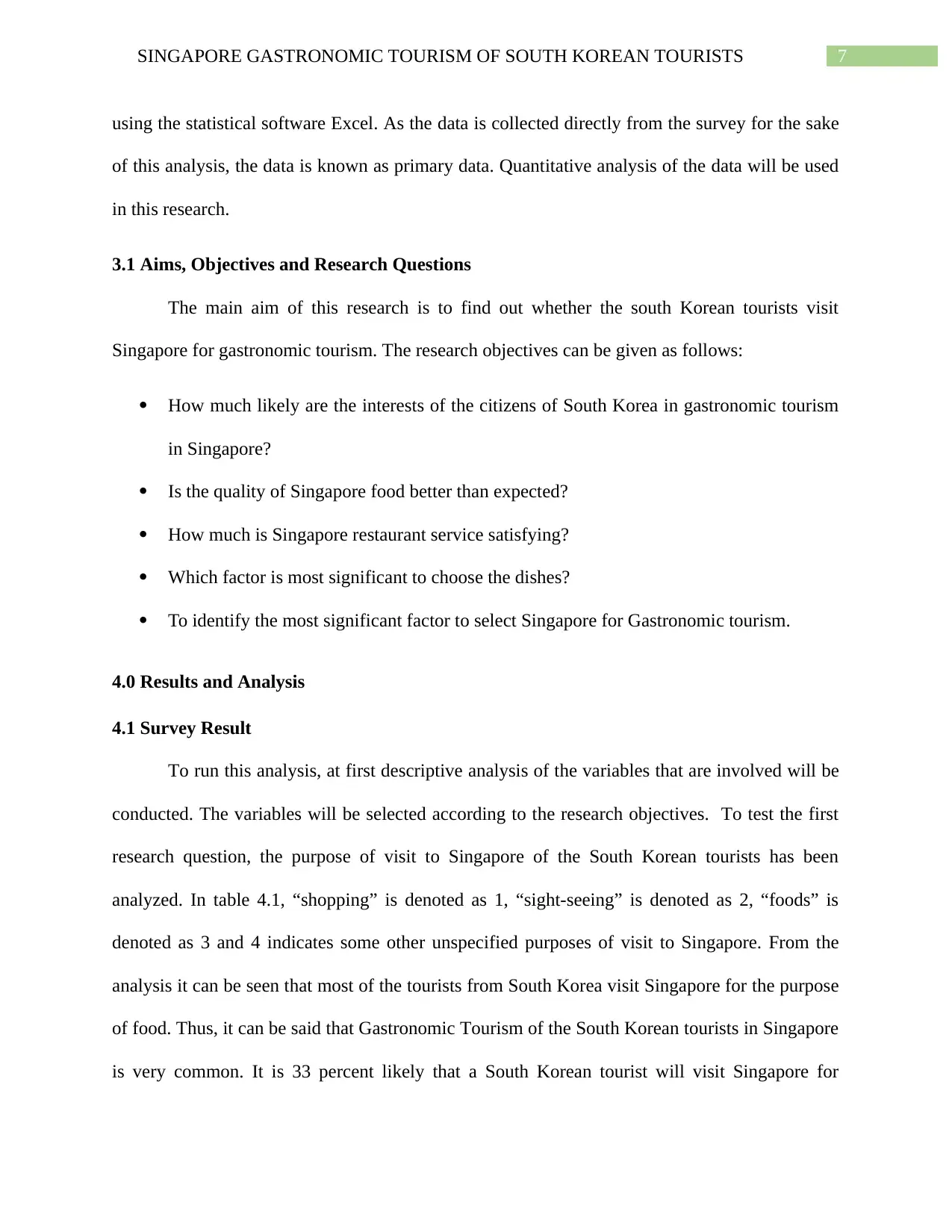
7SINGAPORE GASTRONOMIC TOURISM OF SOUTH KOREAN TOURISTS
using the statistical software Excel. As the data is collected directly from the survey for the sake
of this analysis, the data is known as primary data. Quantitative analysis of the data will be used
in this research.
3.1 Aims, Objectives and Research Questions
The main aim of this research is to find out whether the south Korean tourists visit
Singapore for gastronomic tourism. The research objectives can be given as follows:
How much likely are the interests of the citizens of South Korea in gastronomic tourism
in Singapore?
Is the quality of Singapore food better than expected?
How much is Singapore restaurant service satisfying?
Which factor is most significant to choose the dishes?
To identify the most significant factor to select Singapore for Gastronomic tourism.
4.0 Results and Analysis
4.1 Survey Result
To run this analysis, at first descriptive analysis of the variables that are involved will be
conducted. The variables will be selected according to the research objectives. To test the first
research question, the purpose of visit to Singapore of the South Korean tourists has been
analyzed. In table 4.1, “shopping” is denoted as 1, “sight-seeing” is denoted as 2, “foods” is
denoted as 3 and 4 indicates some other unspecified purposes of visit to Singapore. From the
analysis it can be seen that most of the tourists from South Korea visit Singapore for the purpose
of food. Thus, it can be said that Gastronomic Tourism of the South Korean tourists in Singapore
is very common. It is 33 percent likely that a South Korean tourist will visit Singapore for
using the statistical software Excel. As the data is collected directly from the survey for the sake
of this analysis, the data is known as primary data. Quantitative analysis of the data will be used
in this research.
3.1 Aims, Objectives and Research Questions
The main aim of this research is to find out whether the south Korean tourists visit
Singapore for gastronomic tourism. The research objectives can be given as follows:
How much likely are the interests of the citizens of South Korea in gastronomic tourism
in Singapore?
Is the quality of Singapore food better than expected?
How much is Singapore restaurant service satisfying?
Which factor is most significant to choose the dishes?
To identify the most significant factor to select Singapore for Gastronomic tourism.
4.0 Results and Analysis
4.1 Survey Result
To run this analysis, at first descriptive analysis of the variables that are involved will be
conducted. The variables will be selected according to the research objectives. To test the first
research question, the purpose of visit to Singapore of the South Korean tourists has been
analyzed. In table 4.1, “shopping” is denoted as 1, “sight-seeing” is denoted as 2, “foods” is
denoted as 3 and 4 indicates some other unspecified purposes of visit to Singapore. From the
analysis it can be seen that most of the tourists from South Korea visit Singapore for the purpose
of food. Thus, it can be said that Gastronomic Tourism of the South Korean tourists in Singapore
is very common. It is 33 percent likely that a South Korean tourist will visit Singapore for
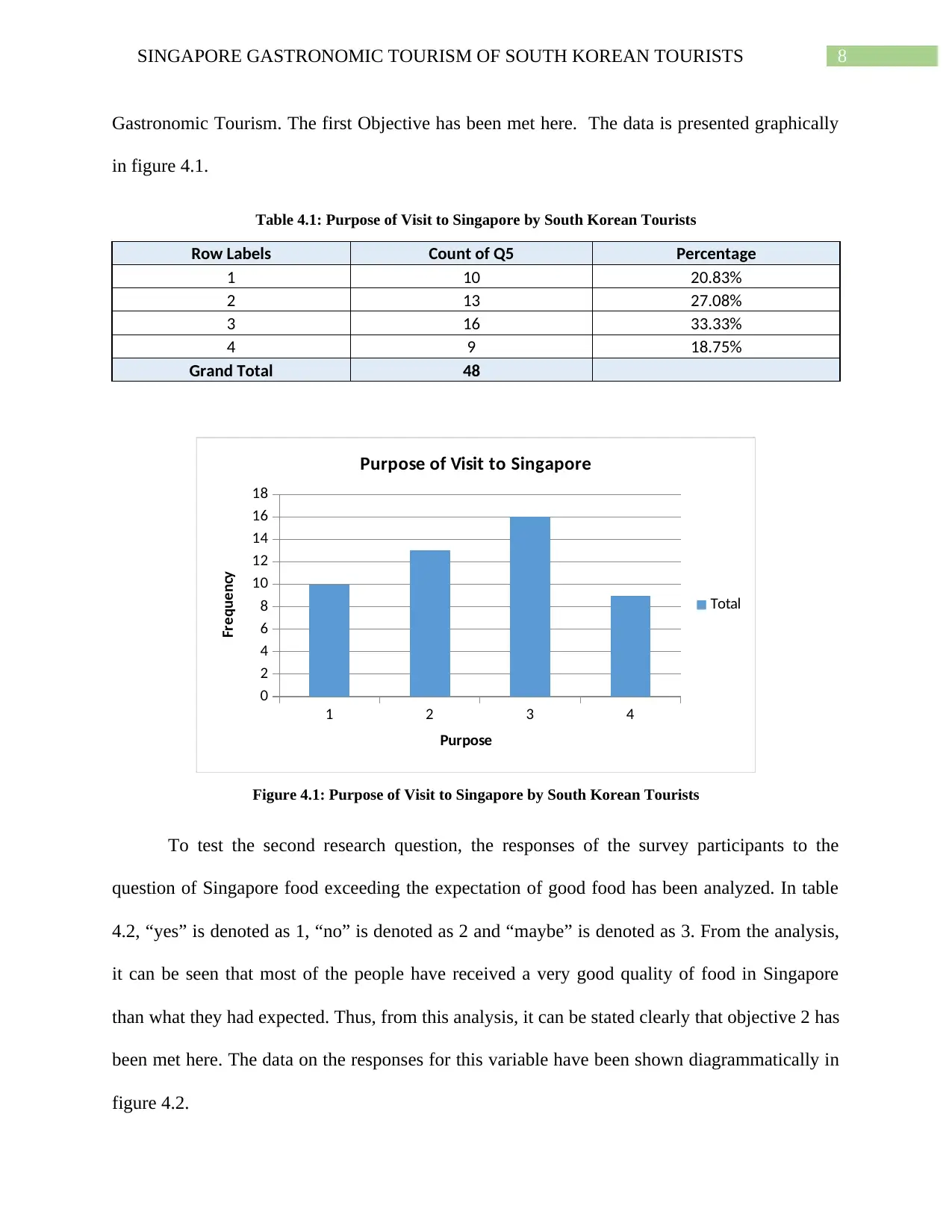
8SINGAPORE GASTRONOMIC TOURISM OF SOUTH KOREAN TOURISTS
Gastronomic Tourism. The first Objective has been met here. The data is presented graphically
in figure 4.1.
Table 4.1: Purpose of Visit to Singapore by South Korean Tourists
Row Labels Count of Q5 Percentage
1 10 20.83%
2 13 27.08%
3 16 33.33%
4 9 18.75%
Grand Total 48
1 2 3 4
0
2
4
6
8
10
12
14
16
18
Purpose of Visit to Singapore
Total
Purpose
Frequency
Figure 4.1: Purpose of Visit to Singapore by South Korean Tourists
To test the second research question, the responses of the survey participants to the
question of Singapore food exceeding the expectation of good food has been analyzed. In table
4.2, “yes” is denoted as 1, “no” is denoted as 2 and “maybe” is denoted as 3. From the analysis,
it can be seen that most of the people have received a very good quality of food in Singapore
than what they had expected. Thus, from this analysis, it can be stated clearly that objective 2 has
been met here. The data on the responses for this variable have been shown diagrammatically in
figure 4.2.
Gastronomic Tourism. The first Objective has been met here. The data is presented graphically
in figure 4.1.
Table 4.1: Purpose of Visit to Singapore by South Korean Tourists
Row Labels Count of Q5 Percentage
1 10 20.83%
2 13 27.08%
3 16 33.33%
4 9 18.75%
Grand Total 48
1 2 3 4
0
2
4
6
8
10
12
14
16
18
Purpose of Visit to Singapore
Total
Purpose
Frequency
Figure 4.1: Purpose of Visit to Singapore by South Korean Tourists
To test the second research question, the responses of the survey participants to the
question of Singapore food exceeding the expectation of good food has been analyzed. In table
4.2, “yes” is denoted as 1, “no” is denoted as 2 and “maybe” is denoted as 3. From the analysis,
it can be seen that most of the people have received a very good quality of food in Singapore
than what they had expected. Thus, from this analysis, it can be stated clearly that objective 2 has
been met here. The data on the responses for this variable have been shown diagrammatically in
figure 4.2.
⊘ This is a preview!⊘
Do you want full access?
Subscribe today to unlock all pages.

Trusted by 1+ million students worldwide
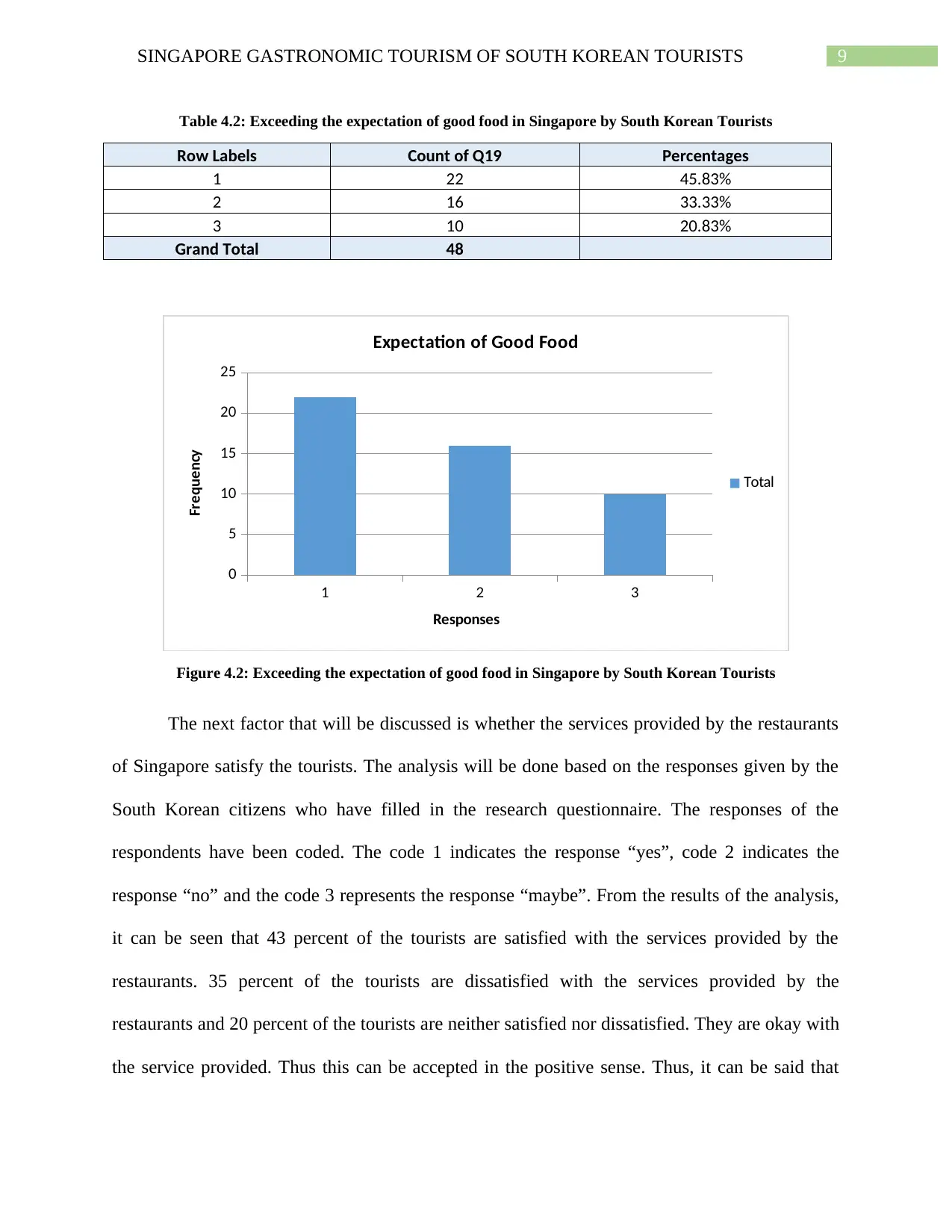
9SINGAPORE GASTRONOMIC TOURISM OF SOUTH KOREAN TOURISTS
Table 4.2: Exceeding the expectation of good food in Singapore by South Korean Tourists
Row Labels Count of Q19 Percentages
1 22 45.83%
2 16 33.33%
3 10 20.83%
Grand Total 48
1 2 3
0
5
10
15
20
25
Expectation of Good Food
Total
Responses
Frequency
Figure 4.2: Exceeding the expectation of good food in Singapore by South Korean Tourists
The next factor that will be discussed is whether the services provided by the restaurants
of Singapore satisfy the tourists. The analysis will be done based on the responses given by the
South Korean citizens who have filled in the research questionnaire. The responses of the
respondents have been coded. The code 1 indicates the response “yes”, code 2 indicates the
response “no” and the code 3 represents the response “maybe”. From the results of the analysis,
it can be seen that 43 percent of the tourists are satisfied with the services provided by the
restaurants. 35 percent of the tourists are dissatisfied with the services provided by the
restaurants and 20 percent of the tourists are neither satisfied nor dissatisfied. They are okay with
the service provided. Thus this can be accepted in the positive sense. Thus, it can be said that
Table 4.2: Exceeding the expectation of good food in Singapore by South Korean Tourists
Row Labels Count of Q19 Percentages
1 22 45.83%
2 16 33.33%
3 10 20.83%
Grand Total 48
1 2 3
0
5
10
15
20
25
Expectation of Good Food
Total
Responses
Frequency
Figure 4.2: Exceeding the expectation of good food in Singapore by South Korean Tourists
The next factor that will be discussed is whether the services provided by the restaurants
of Singapore satisfy the tourists. The analysis will be done based on the responses given by the
South Korean citizens who have filled in the research questionnaire. The responses of the
respondents have been coded. The code 1 indicates the response “yes”, code 2 indicates the
response “no” and the code 3 represents the response “maybe”. From the results of the analysis,
it can be seen that 43 percent of the tourists are satisfied with the services provided by the
restaurants. 35 percent of the tourists are dissatisfied with the services provided by the
restaurants and 20 percent of the tourists are neither satisfied nor dissatisfied. They are okay with
the service provided. Thus this can be accepted in the positive sense. Thus, it can be said that
Paraphrase This Document
Need a fresh take? Get an instant paraphrase of this document with our AI Paraphraser
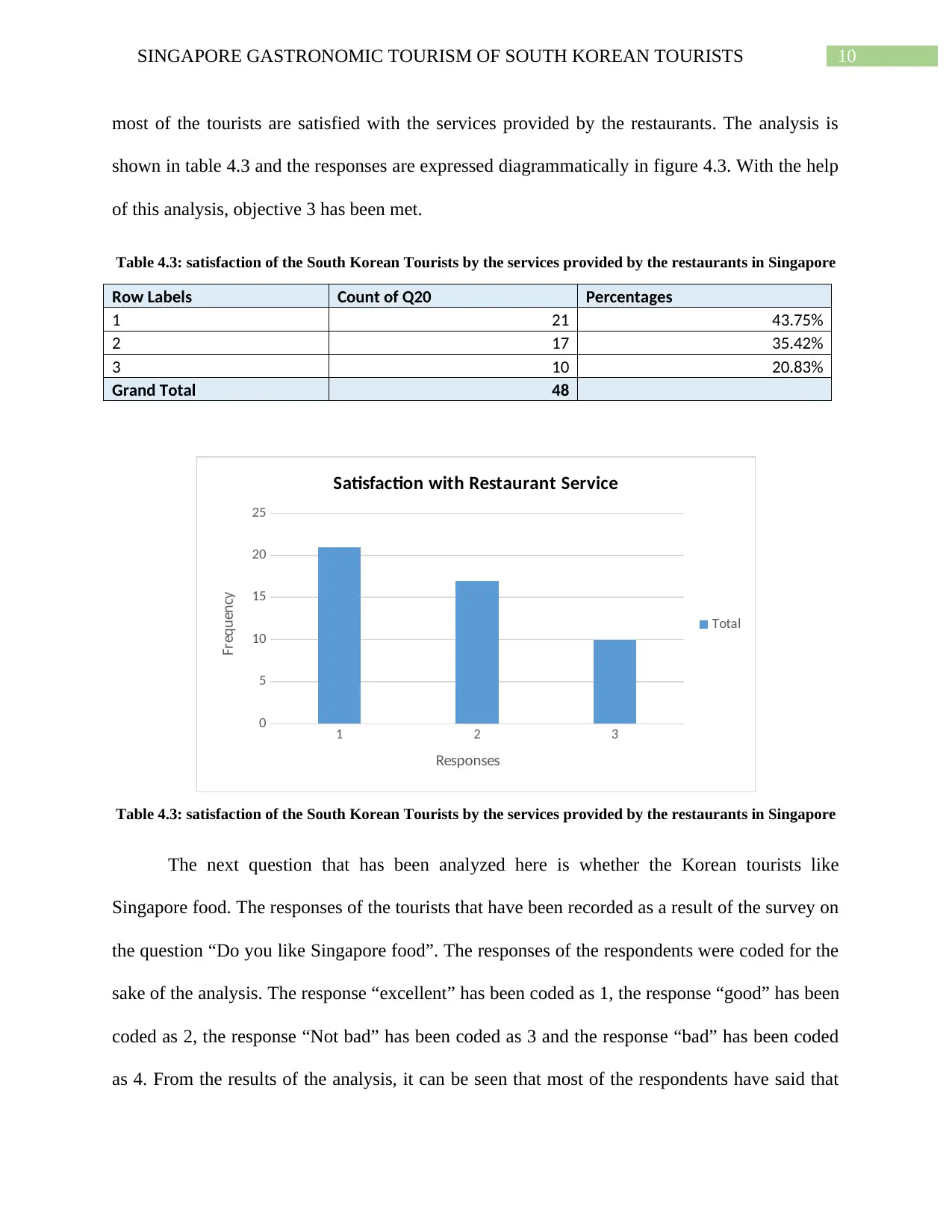
10SINGAPORE GASTRONOMIC TOURISM OF SOUTH KOREAN TOURISTS
most of the tourists are satisfied with the services provided by the restaurants. The analysis is
shown in table 4.3 and the responses are expressed diagrammatically in figure 4.3. With the help
of this analysis, objective 3 has been met.
Table 4.3: satisfaction of the South Korean Tourists by the services provided by the restaurants in Singapore
Row Labels Count of Q20 Percentages
1 21 43.75%
2 17 35.42%
3 10 20.83%
Grand Total 48
1 2 3
0
5
10
15
20
25
Satisfaction with Restaurant Service
Total
Responses
Frequency
Table 4.3: satisfaction of the South Korean Tourists by the services provided by the restaurants in Singapore
The next question that has been analyzed here is whether the Korean tourists like
Singapore food. The responses of the tourists that have been recorded as a result of the survey on
the question “Do you like Singapore food”. The responses of the respondents were coded for the
sake of the analysis. The response “excellent” has been coded as 1, the response “good” has been
coded as 2, the response “Not bad” has been coded as 3 and the response “bad” has been coded
as 4. From the results of the analysis, it can be seen that most of the respondents have said that
most of the tourists are satisfied with the services provided by the restaurants. The analysis is
shown in table 4.3 and the responses are expressed diagrammatically in figure 4.3. With the help
of this analysis, objective 3 has been met.
Table 4.3: satisfaction of the South Korean Tourists by the services provided by the restaurants in Singapore
Row Labels Count of Q20 Percentages
1 21 43.75%
2 17 35.42%
3 10 20.83%
Grand Total 48
1 2 3
0
5
10
15
20
25
Satisfaction with Restaurant Service
Total
Responses
Frequency
Table 4.3: satisfaction of the South Korean Tourists by the services provided by the restaurants in Singapore
The next question that has been analyzed here is whether the Korean tourists like
Singapore food. The responses of the tourists that have been recorded as a result of the survey on
the question “Do you like Singapore food”. The responses of the respondents were coded for the
sake of the analysis. The response “excellent” has been coded as 1, the response “good” has been
coded as 2, the response “Not bad” has been coded as 3 and the response “bad” has been coded
as 4. From the results of the analysis, it can be seen that most of the respondents have said that
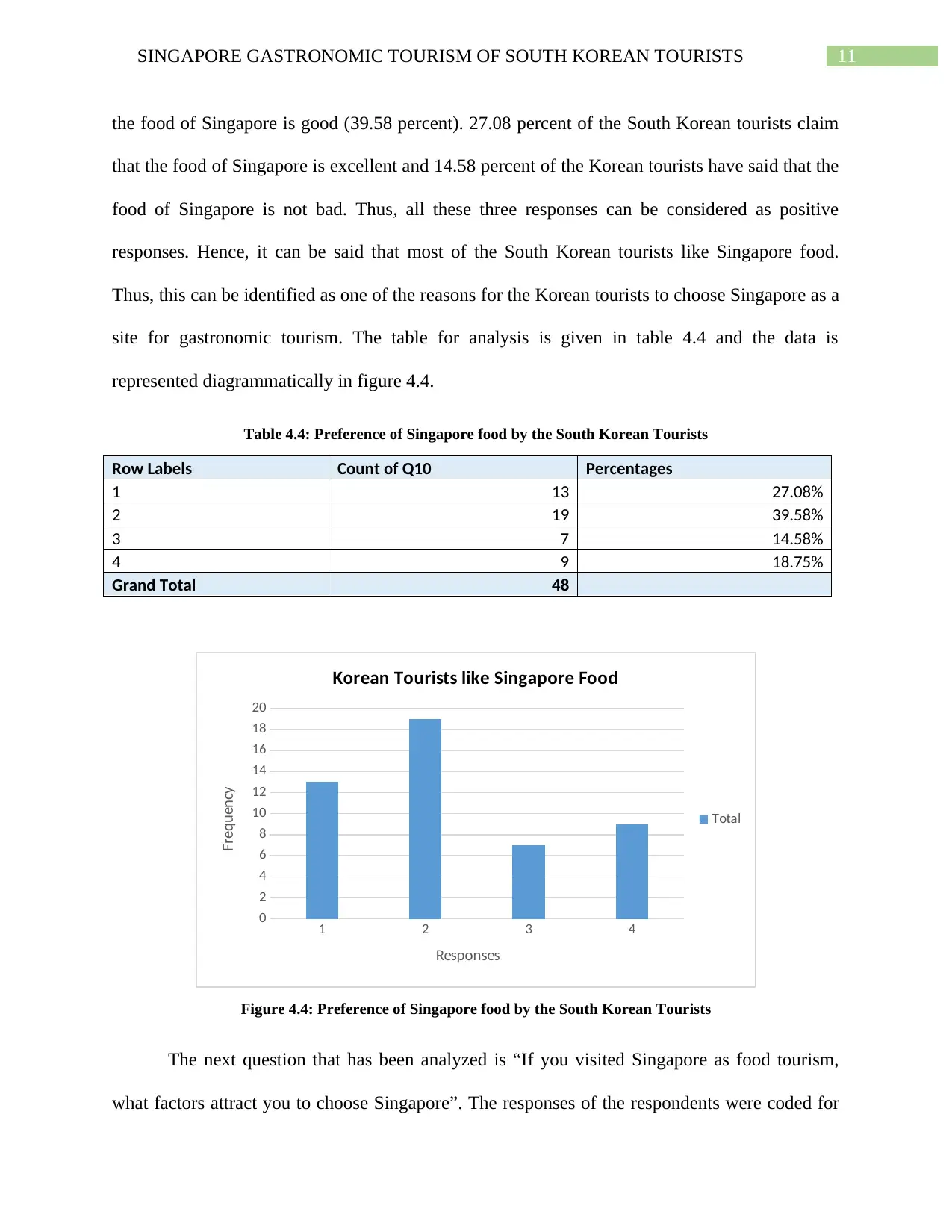
11SINGAPORE GASTRONOMIC TOURISM OF SOUTH KOREAN TOURISTS
the food of Singapore is good (39.58 percent). 27.08 percent of the South Korean tourists claim
that the food of Singapore is excellent and 14.58 percent of the Korean tourists have said that the
food of Singapore is not bad. Thus, all these three responses can be considered as positive
responses. Hence, it can be said that most of the South Korean tourists like Singapore food.
Thus, this can be identified as one of the reasons for the Korean tourists to choose Singapore as a
site for gastronomic tourism. The table for analysis is given in table 4.4 and the data is
represented diagrammatically in figure 4.4.
Table 4.4: Preference of Singapore food by the South Korean Tourists
Row Labels Count of Q10 Percentages
1 13 27.08%
2 19 39.58%
3 7 14.58%
4 9 18.75%
Grand Total 48
1 2 3 4
0
2
4
6
8
10
12
14
16
18
20
Korean Tourists like Singapore Food
Total
Responses
Frequency
Figure 4.4: Preference of Singapore food by the South Korean Tourists
The next question that has been analyzed is “If you visited Singapore as food tourism,
what factors attract you to choose Singapore”. The responses of the respondents were coded for
the food of Singapore is good (39.58 percent). 27.08 percent of the South Korean tourists claim
that the food of Singapore is excellent and 14.58 percent of the Korean tourists have said that the
food of Singapore is not bad. Thus, all these three responses can be considered as positive
responses. Hence, it can be said that most of the South Korean tourists like Singapore food.
Thus, this can be identified as one of the reasons for the Korean tourists to choose Singapore as a
site for gastronomic tourism. The table for analysis is given in table 4.4 and the data is
represented diagrammatically in figure 4.4.
Table 4.4: Preference of Singapore food by the South Korean Tourists
Row Labels Count of Q10 Percentages
1 13 27.08%
2 19 39.58%
3 7 14.58%
4 9 18.75%
Grand Total 48
1 2 3 4
0
2
4
6
8
10
12
14
16
18
20
Korean Tourists like Singapore Food
Total
Responses
Frequency
Figure 4.4: Preference of Singapore food by the South Korean Tourists
The next question that has been analyzed is “If you visited Singapore as food tourism,
what factors attract you to choose Singapore”. The responses of the respondents were coded for
⊘ This is a preview!⊘
Do you want full access?
Subscribe today to unlock all pages.

Trusted by 1+ million students worldwide
1 out of 23
Related Documents
Your All-in-One AI-Powered Toolkit for Academic Success.
+13062052269
info@desklib.com
Available 24*7 on WhatsApp / Email
![[object Object]](/_next/static/media/star-bottom.7253800d.svg)
Unlock your academic potential
Copyright © 2020–2025 A2Z Services. All Rights Reserved. Developed and managed by ZUCOL.





